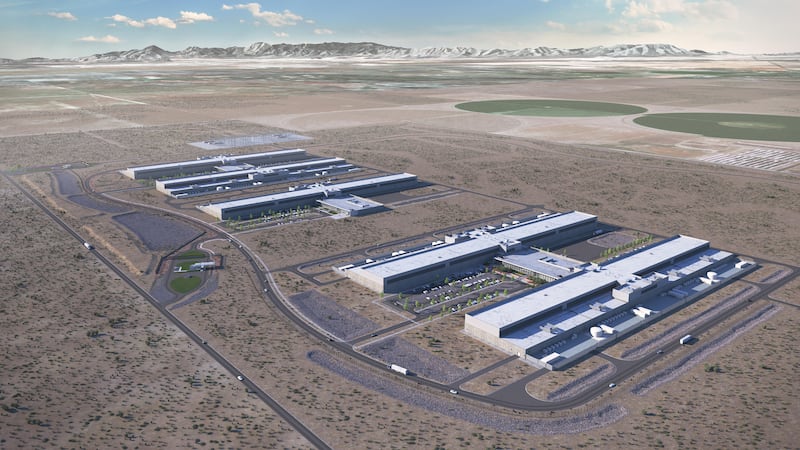Facebook and its nearly 3 billion users will have even more room to store all the life moments and minutiae fit to post following a Thursday announcement of plans to further expand the company’s massive data storage facility in this Utah County community.
Two new buildings totaling 900,000 square feet represent the third phase of a project, which broke ground in 2018, that already has nearly 1,500,000 square feet of warehouses under construction. Almost the entirety of that space will house rows of data storage equipment intended to help keep the world’s largest social media platform up and running and accommodating ongoing growth.
The company reports it has invested over $1 billion in the Eagle Mountain facility so far, with over 4 million work hours having gone into a project that’s included erecting over 12,000 tons of steel and pouring over 100,000 cubic yards of concrete.
While none of the new digital storage capacity has been activated for use as of yet, a Facebook spokeswoman said two of the first three buildings are nearing completion and the company expects to be online sometime this year.
Exactly how much data the facility will be able to hold is a little murky, and the company isn’t saying, but experts estimate the highly secretive National Security Agency data center in Bluffdale, which has a similar footprint, might accommodate 3-12 exabytes of data.
And don’t feel bad if you haven’t heard of an exabyte, the term for 1,0006 or 1,000,000,000,000,000,000 bytes of information.
This week’s news comes as no surprise as the company predicted, when it unveiled its project in May 2018, that the facility could be built out in as many as five phases. If all five phases are completed in the next few decades, Facebook is set to harvest a potential $750 million in taxpayer subsidies along the way.
Months of intrigue and controversy preceded the revelation that Facebook was the company behind the mammoth project, which includes construction of enormous warehouse-style buildings that house thousands of computer servers — the hardware behind the digital “cloud” — that store and process data.
The open-ended incentive agreements, however, extend public benefits beyond the first phase and could land the company hundreds of millions in additional tax relief over the next four decades.
Those benefits will go to a company that had some $86 billion in revenues last year, according to market data reporter Statista. That’s up from $70.7 billion in 2019. At the end of regular trading on Wednesday, Facebook had a market capitalization of over $774 billion.
In addition to its capital costs, Facebook is investing about $150 million in infrastructure improvements, including bringing power to the 500-acre site from a nearby high-capacity power line corridor, extending sewer and water service, bringing in telecommunication lines and improving roads.
That infrastructure investment is expected to be equalized by the Phase 1 tax benefits of $150 million over 20 years. That tax break gives Facebook 100% tax relief on personal property taxes due and 80% relief on real property taxes due for a term of 40 years for four of the five taxing entities it’s beholden to.
Only the Alpine School Board created some caps on those benefits, with limits of $40 million per phase and $120 million total over 35 years. Alpine School District represents the biggest beneficiary of the taxes Facebook will pay — and the entity giving up the most via the tax break package — as the recipient of about 70% of the total taxes due. The company will also enjoy some sales tax exemptions, created specifically for data centers by the Utah Legislature.
A study commissioned by Eagle Mountain on the project detailed that if Facebook carries the project through five phases inside the 40-year limit, the company would earn $750 million in tax relief.
While data centers represent large capital investments for the companies that construct them, the operations themselves require relatively little in terms of human staffing. The Facebook facility will require only a few dozen people to operate, though the company says the project will “support” 200 jobs on completion.
Utah is currently home to numerous data centers, including facilities operated by eBay, Twitter, Oracle and the National Security Agency.


